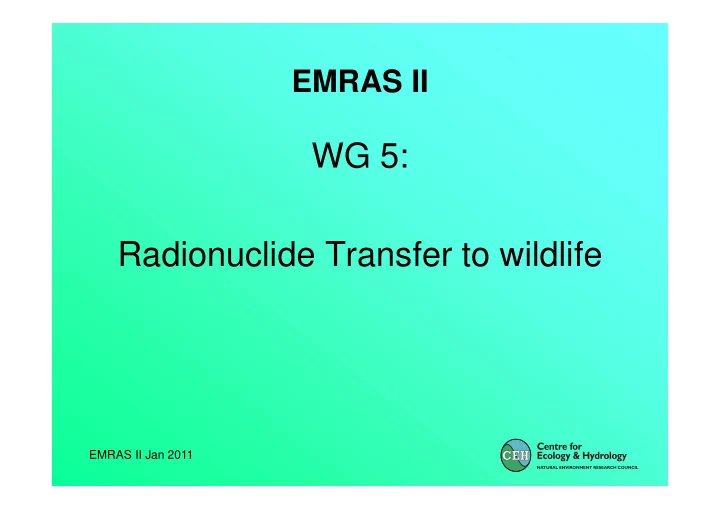

EMRAS II WG 5: Radionuclide Transfer to wildlife EMRAS II Jan 2011
TRS: RADIONUCLIDE TRANSFER TO WILDLIFE EMRAS II Jan 2011
Activities • Key output TRS on transfer to wildlife – Core ‘drafting group’ • On-line database – all contributions acknowledged in TRS • Publication in Radiation Environ Biophys • First draft considered at TM in 2010 • Second draft considered in mid term meeting in Sept 2010 • Final draft at this meeting EMRAS II Jan 2011
Equilibrium whole organism concentration ratios (CR wo ) • used to predict radionuclide activity concentrations in wildlife from exposure to radionuclides in media. • The CR wo value is defined as the radionuclide conc in whole organism (Bq/kg fw) divided by the radionuclide concentration in the media (Bq/kg dw soil, water or sediment) or Bq/m 3 air) EMRAS II Jan 2011
Database • Collate & summarise transfer data • Outputs – IAEA handbook – ICRP transfer task group • Database will remain available • Regular updates EMRAS II Jan 2011
Objectives Provide IAEA Member States with data for use in the radiological assessment of wildlife as a consequence of routine discharges of radionuclides to the environment and existing contamination situations. Application to accidental release is also considered. EMRAS II Jan 2011
CONTENTS 1. INTRODUCTION • Background • Objectives • Scope • Structure EMRAS II Jan 2011
2. CONCEPTS AND QUANTIFICATION – Transfer processes and exposure pathways • Physical and chemical processes • Biological uptake • Exposure routes – Current approaches used in assessment models • Equilibrium Concentration Ratios • Specific activity approaches • Approach used in this handbook EMRAS II Jan 2011
3. DATA COLLATION, MANIPULATION AND EVALUATION – Purpose of the wildlife transfer database – Structure of the wildlife transfer database • Data entry issues – Data transformations – Calculation of the summary concentration ratios EMRAS II Jan 2011
4. TRANSFER VALUES FOR WILDLIFE CR WO tables for: – Terrestrial environments – Freshwater environments – Marine environments – Estuarine environments Guidance on how to use the values provided EMRAS II Jan 2011
5. APPROACHES FOR FILLING DATA GAPS – Surrogate organisms – Phylogenetic relationships – Biogeochemical analogues and ionic potential – Allometry – Data from a different ecosystem – Use of published reviews EMRAS II Jan 2011
6. CURRENT LIMITATIONS OF THE APPROACH AND DATA • Appendix I. Tissue conversion tables • Appendix II : References for CR wo tables • Appendix III: glossary • References • Contributors to drafting and review EMRAS II Jan 2011
This week • Sessions – Monday afternoon • Briefing on final data selection for TRS • Handbook comments – Thursday • Handbook comments • Presentations on the CR wo values • Using the new TRS values for different sources / applications • Future actions EMRAS II Jan 2011
Recommend
More recommend